Buyer Intent Data For B2B: Types, Tools, and Use Cases

A guest blog contributed by Yulia Olennikova, Head of Marketing at N.Rich, an ABM advertizing and intent data platform
Have you ever played poker?
Imagine for a moment that you’re seated at a green felt table, the air thick with tension. In front of you, competitors with their poker faces on.
But in this high-stakes game, you’ve got an edge.
A slight tell in your opponent’s behavior and you know what’s in their hand. That’s power.
Now, let’s take a leap from the poker table to the B2B business world.
Your opponents? – Potential customers.
Their tell? – Buyer intent data.
This article is your guide to mastering the art of reading your customer’s intentions, understanding the types of intent data, and harnessing the power of tools and use cases to achieve B2B excellence.
What Is Buyer Intent Data?
Picture this: You’re back at that poker table, your mind brimming with strategies, your heart pounding with anticipation.
But here’s the thing – you don’t have to play blind. There’s a card up your sleeve, and that’s buyer intent data. It’s the digital breadcrumbs potential customers leave behind as they navigate the vast landscape of the internet.
These traces, when analyzed and interpreted, can reveal an astonishingly detailed picture of what your customers are planning to do.
And, no, buyer intent data is not just about understanding who your customers are.
It goes a step further.
It’s about predicting what they’re likely to do next.
It tells you which potential customers are actively in the market, what products or services they’re interested in, and how ready they are to make a purchase.
It’s like having a magic mirror that reflects your customer’s desires, their hesitations, their intent.
Imagine the possibilities! (You don’t actually have to go over them in a second.)
So, how does this powerful tool work?
It all starts with understanding the types of intent data.
Main Types of Intent Data
Just like a deck of cards, intent data comes in different suits, each holding its unique value and role in the game.
As a B2B professional, understanding these categories is crucial for leveraging the full potential of buyer intent data.
So, let’s shuffle through the three main types of intent data: first-party, second-party, and third-party.
First-Party Intent Data
First-party intent data is the ace up your sleeve.
This data is collected directly from your own digital properties, such as your website, social media channels, or email interactions.
It’s the raw, unfiltered insights into how potential customers engage with your content and brand.
First-party data allows you to analyze user behavior, such as page views, time spent on site, downloads, and form submissions.
This information is invaluable for identifying the most engaged prospects and determining which stage of the buyer’s journey they are in.
Second-Party Intent Data
Second-party intent data is like having a trusted partner at the poker table.
It’s the data you acquire from another organization, usually through a direct agreement or partnership.
It might be a publisher, a partner, or even a competitor who has collected first-party data on their own digital properties.
By sharing data, both parties benefit from a broader perspective and deeper insights.
It helps you to identify new potential customers, learn about their interests and preferences, and gain insights into their behavior on other platforms.
Third-Party Intent Data
Third-party intent data is like an expert card counter who has surveyed the room and knows what everyone else is holding.
It’s the data aggregated from various sources, collected by specialized data providers that monitor and track user behavior across a multitude of websites, forums, and platforms.
This data can offer insights into topics your prospects are researching, the content they’re consuming, and even the competitor brands they’re evaluating.
With third-party intent data, you can identify high-intent prospects beyond your own sphere of influence, giving you a competitive edge in your B2B journey.
Now that we’ve dealt the cards and you have a firm grasp of the main types of intent data, let’s explore the winning hand – the use cases that will help you achieve B2B excellence.
7 Use Cases for Intent Data
Now that we’ve unveiled the secrets behind the main types of intent data, it’s time to play our hand and unleash the true potential of this mighty tool.
But how exactly can you use it to your advantage?
In this section, we’ll deal with seven powerful intent data use cases, each designed to help you optimize your efforts and maximize your ROI.
So, pull up a chair and get ready to play, as we explore the exciting realm of intent data use cases.
Use Case #1: Build Target Account Lists
Who is it for: sales, marketing, operations
When playing poker, you want to know which opponents are worth betting against.
In the B2B world, this translates to identifying the right target accounts to focus your efforts on.
Buyer intent data can help you do just that.
By analyzing the digital breadcrumbs of potential customers, you can determine which prospects are actively researching and engaging with products or services like yours. This information enables you to create highly targeted account lists, focusing on high-intent prospects that are more likely to convert.
With targeted account lists in hand, your sales, marketing, and operations teams can work in harmony, aligning their strategies to nurture and engage these high-potential leads throughout the buyer’s journey, ultimately driving revenue growth.
Use Case #2: Improve Outreach Results
Who is it for: sales
In the game of poker, timing is everything.
A well-timed bet can make all the difference between winning big or losing it all.
The same is true for sales outreach.
By leveraging buyer intent data, you can time your outreach efforts to perfection, striking when the iron is hot.
Intent data helps you identify the right moment when a prospect is actively engaging with relevant content, signaling that they are open to discussing your product or service.
With this knowledge, your sales team can craft personalized messages that address the prospect’s needs and pain points, increasing the likelihood of a positive response. Consider creating custom message templates with Surfe when you prospect on LInkedIn.
The result?
Improved outreach results, higher conversion rates, and a stronger sales pipeline, all thanks to the power of buyer intent data.
Use Case #3: Identify Website Visitors
Who is it for: sales, marketing
In the world of poker, knowing your opponent’s hand gives you a significant advantage.
Similarly, understanding who visits your website can provide valuable insights into potential customers.
Buyer intent data can help you lift the veil and identify anonymous website visitors.
By analyzing visitor behavior, such as the pages they view, the content they download, and the forms they submit, you can not only identify these visitors but also gauge their level of interest.
This information empowers your sales and marketing teams to tailor their outreach efforts, engaging visitors with personalized content that addresses their needs and pain points.
As a result, you can convert anonymous website visitors into known prospects, nurturing them into valuable customers and driving revenue growth.
Use Case #4: Enhance Account Scoring
Who is it for: operations, sales, marketing
In a poker game, understanding the strength of your hand is essential for making informed decisions.
In the realm of B2B, account scoring plays a similar role, helping you assess the potential value of a prospect.
Buyer intent data can significantly enhance this process, giving you a more accurate picture of your prospect’s intentions.
By incorporating intent data into your account scoring models, you can identify high-intent prospects and prioritize them based on their likelihood to convert.
This information enables your operations, sales, and marketing teams to focus their efforts on the most promising leads, optimizing resources and maximizing ROI.
Ultimately, enhanced account scoring with buyer intent data can lead to more accurate forecasts, improved sales and marketing alignment, and better business outcomes.
Use Case #5: Launch ABM Campaigns
Who is it for: operations, sales, marketing
ABM or Account-Based Marketing is like a poker strategy tailored to beat a specific opponent.
It’s about focusing your resources on a select group of high-value accounts, and intent data is the secret ingredient to turbocharge your ABM campaigns.
By providing detailed insights into the behavior and interests of your target accounts, intent data empowers you to craft highly personalized campaigns. It’s as if you’re reading your opponent’s poker hand, knowing their preferences, understanding their pain points, and tailoring your message to resonate with them.
Operations, sales, and marketing teams, armed with these insights, can collaborate effectively, delivering the right message to the right account at the right time.
The result?
Highly targeted ABM campaigns that drive engagement, accelerate the sales cycle, and maximize return on investment.
Use Case #6: Steal Competitor Prospects
Who is it for: operations, sales
Poker is all about outsmarting your opponents.
In business, that means seizing opportunities to win over prospects considering your competitors.
And, in the world of B2B, it’s not as sinister as it sounds.
It’s simply about outplaying your competitors at the poker table and winning the pot.
And guess what?
Buyer intent data is your ace in the hole.
With buyer intent data, you can easily identify prospects who are engaging with your competitors and strategically position your brand to win them over.
Your operations and sales teams can analyze buyer intent data to understand the pain points, preferences, and interests of these prospects, and then craft compelling pitches that highlight your unique value proposition.
By showcasing how your offerings can better address their needs, you can effectively steal your competitor’s prospects and turn them into your own customers.
Leveraging intent data in this manner can help you stay one step ahead of the competition and secure valuable market share, all while keeping your brand top-of-mind among high-intent prospects.
The possibilities are endless with buyer intent data on your side.
Use Case #7: Personalize Messaging
Who is it for: marketing, sales
In poker, you often adjust your playstyle to counter your opponents’ strategies.
Similarly, personalizing your messaging to cater to individual prospects can be the key to winning their business.
And that’s where buyer intent data comes into play.
Intent data lets you peek into your prospects’ interests, needs, and pain points by analyzing their online behavior.
It’s like reading their poker face and adjusting your tactics accordingly.
Your marketing and sales teams can use this invaluable information to create customized messaging that truly resonates with each prospect.
By tailoring content, offers, and communication based on your prospects’ intent data, you’ll not only capture their attention but also foster trust and build lasting relationships.
Personalized messaging driven by buyer intent data not only enhances customer experience but also boosts conversion rates, ensuring you emerge as the undisputed winner in the B2B arena.
Now that you’ve got a winning hand with these powerful use cases, let’s explore the top tools that can help you harness the full potential of buyer intent data.

Tie it all together with Surfe
Bring all of the buyer intent data you have in your CRM everywhere you go with Surfe. Display CRM data directly on LinkedIn profiles and add LinkedIn contacts to your CRM in one click.
Buyer Intent Data Tools
Equipped with the knowledge of how buyer intent data can elevate your B2B strategies, it’s time to select the right tools to put your newfound insights into action.
Choosing the perfect tool is like picking the right poker strategy – it can make all the difference in your game.
In this section, we’ll introduce you to some of the top buyer intent data tools on the market. Each has its unique features, data types, and pricing structures, allowing you to find the one that best suits your business needs and budget.
From first-party data powerhouses to third-party data specialists, these tools will help you tap into the vast potential of buyer intent data and drive your B2B efforts to new heights.
Let’s dive in and discover the tools that can help you become a true B2B maestro.
G2
Type: second-party data
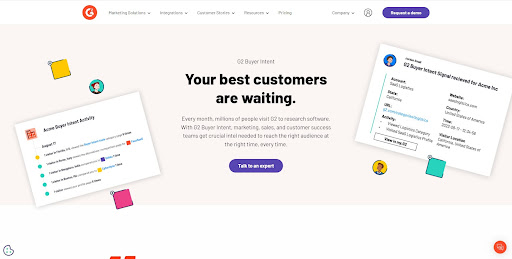
G2 is like your trusted poker buddy, providing you with valuable insights to help you make better decisions. As a leading B2B software and services review platform, G2 offers second-party buyer intent data that allows your marketing, sales, and customer success teams connect with their target audience at just the right moment.
Main features:
Intent Signals: Discover which companies are researching your products or solutions.
Content Tracking: Monitor the content being consumed by companies.
Buyer Journey Insights: Gain insights into companies’ buyer journeys, so you know the best time to engage them.
Pricing:
Contact G2 for pricing information.
N.Rich
Type: combination of first and third party data
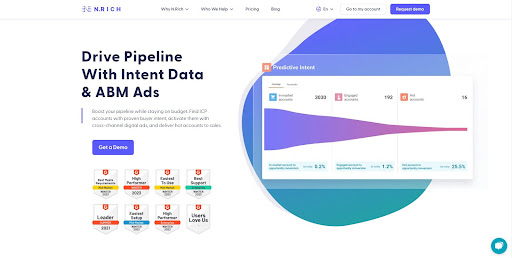
N.Rich is like the poker ace up your sleeve, providing you with a comprehensive view of your prospects’ intent. This ABM platform combines first-party data from your website with third-party data from external sources, offering a holistic picture of buyer intent.
Main features:
Combination of 1st- and 3rd-party intent data: Assess buyer intent using a mix of first-party and third-party sources.
Proactive intent generation with an in-built advertising tool: Engage prospects early on with valuable content that showcases your product as a potential solution.
Predictive intent: Visualize in-market accounts, evaluate their intent, and identify opportunities for swift action.
Pricing:
Lite plan: $9,750 / year
Growth plan: $23,750 / year
Scale plan: $45,000 / year
Bombora
Type: Third-party data
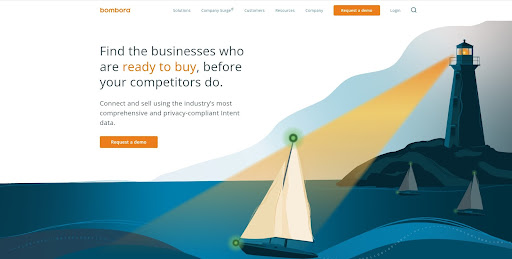
Bombora is the card shark of B2B intent data providers, specializing in delivering insights that enable marketing and sales teams to discern which businesses are actively researching specific topics.
With this information at your disposal, you can prioritize and score accounts, tailor conversations to specific needs, and optimize your marketing initiatives.
Main features:
Robust US data quality: Bombora’s data quality is particularly strong in the United States, thanks to its “co-opting” method of data collection.
Extensive intent topics: Drill down and gain a comprehensive understanding of the specific products or services businesses are interested in.
CRM and MAP integrations: Integrate Bombora with all major CRMs and MAPs for a holistic view of your marketing and sales efforts.
Pricing:
Contact Bombora for pricing information.
Leadfeeder
Type: First-party data
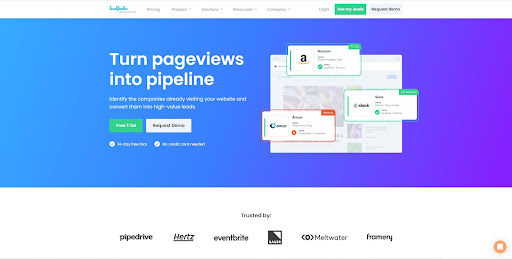
Leadfeeder is like the telltale twitch in your opponent’s face, a potent lead generation tool that uncovers valuable insights about the companies visiting your website. This tool enables you to track online behavior and discern purchasing intent, thereby helping you target your sales and marketing efforts towards the most promising leads.
Main features:
Lead tracking and scoring: Keep track of leads and prioritize the most promising ones.
Always-free plan: Get a taste of the tool’s capabilities with a limited, forever-free plan.
Integrations: Connect Leadfeeder with popular CRM, marketing platforms, and Google Analytics for a seamless experience.
Pricing:
Free plan: 0 USD per month for up to 100 companies, but only retrieves data from the previous 7 days
Premium plan: Priced at $139 per month for up to 100 identified companies and rising to $1049 per month for up to 5,000 companies.
If you need more than 5,000 companies identified, custom pricing is available.
Clearbit
Type: First-party data
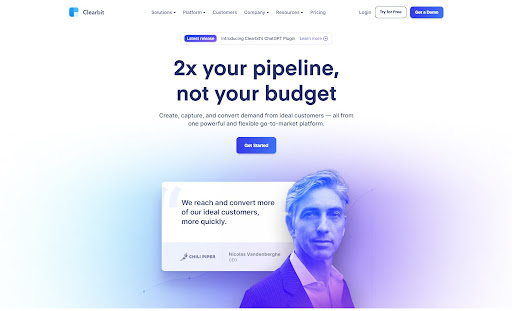
Clearbit is your secret weapon in identifying who’s been checking out your business online. This platform allows you to see which companies and individuals are visiting your website and showing interest in your offerings, empowering you to engage the right companies at the right time.
Main features:
Company and contact-level data: Tailor your marketing and sales messages to the specific needs of each decision-maker.
Good integration ecosystem: Integrate Clearbit Reveal with popular marketing and sales platforms for a streamlined tech stack.
Sales alerts: Receive custom alerts about prospects’ engagement dynamics via Slack, Salesforce, or email.
Pricing:
Free plan available.
Contact Clearbit for more information.
Demandbase
Type: First-party and Third-party data
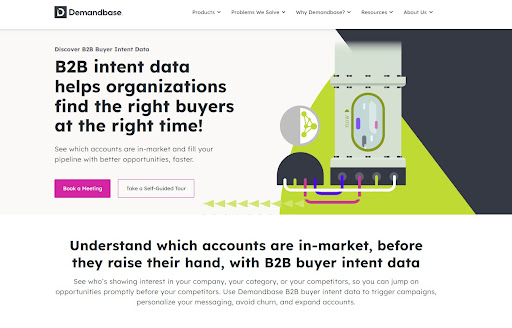
Just like an ace in the hole, Demandbase is a comprehensive account-based marketing solution that empowers B2B marketers to identify, target, and convert the most valuable account prospects. It does this by providing personalized advertising, web experiences, account intelligence, and sales engagement tools tailored to each account.
Main features:
Market Insights: Unearth key trending topics and the accounts showing interest in them.
Account Identification: Determine and prioritize accounts based on account health and potential.
Account-level Insights: Delve into account-level data to understand which channels, tactics, and content are driving engagement.
Pricing:
Contact Demandbase for pricing details.
Lead Forensics
Type: First-party data
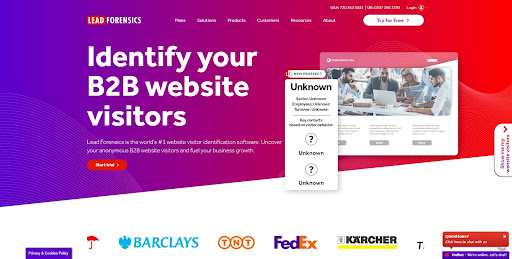
Lead Forensics is the royal flush of intent data platforms, offering a comprehensive view of the businesses visiting your website. This powerful tool provides access to visitor contact information, enabling you to craft personalized marketing campaigns based on diverse factors like on-site behavior, industry, and geography.
Main features:
Segmentation: Enhance your marketing prioritization and effectiveness with customer and prospect segmentation capabilities.
Alerts: Stay in the loop with buyer intent alerts delivered in a format that suits you best, be it email, text message, etc.
Real-time Intent: Benefit from a dashboard that showcases intent data streaming in real time, as opposed to bulk deliveries.
Pricing:
Contact Lead Forensics for pricing information.
Conclusion
So, the cards have been dealt and it’s up to you to play your hand.
The world of B2B business is a high-stakes poker game, and buyer intent data is the royal flush you need to win.
With the right tools and understanding, you can anticipate your customers’ needs, strategize with precision, and close deals with confidence.
Remember, in the game of B2B sales and marketing, the house doesn’t always win.
It’s the player who can read the table best.
Will that be you?

Close deals with confidence
Automate your LinkedIn prospection, personalize your messaging outreach, and analyze your results with Surfe.


